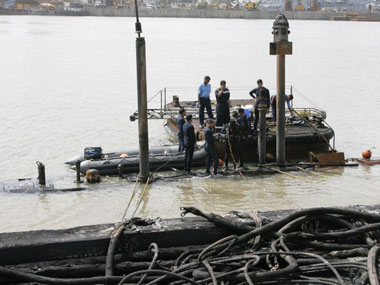One point need to be emphasised upfront with regard to the sinking of INS Sindhurakshak after explosions and fire on 14 August while the 16-year-old submarine, bought from Russia, was docked at Mumbai naval dockyard: the incident will not affect Indo-Russian ties. As of now, there is nothing to suggest in the power corridors of New Delhi that Indians are going to play the blame game with the Russians as the 2300-tonnes diesel-powered vessel had last year returned from Russia after a substantial upgrade, costing $ 18 million. On the contrary, the Indian officials find the Russians very cooperative. On Friday, Russian Deputy Prime Minister Dmitry Rogozin, who is also in charge of the Russian defence industry, made twin offers to India: to help India probe the causes of the submarine explosion by sending Russian specialists and to strengthen Indian Navy’s muscle power depleted by the loss of INS Sindhurakshak. This is what Rogozin said: “Whatever the outcome [of the Sindhurakshak blast probe], India remains our leading partner, not just only in the off-the-shelf purchases of weapon platforms…India is our premier partner for the long haul in co-development of military hardware. We will help India build up its capabilities in this sphere.” [caption id=“attachment_1041641” align=“alignleft” width=“380”] Navy divers at the conning tower of the stricken INS Sindhurakshak, after the submarine sank following an explosion at the naval dockyard in Mumba. AFP[/caption] Russia can offer immediate help to India in two very important ways: (i) first, by giving midlife-upgrade to India’s already aging nine Kilo class submarines which can increase their combat life by at least seven to eight years; and second, by leasing to India three or four nuclear submarines like it has already leased INS Chakra to India. There is a strong possibility that India will go to the Russians on both these points. The first is a time consuming affair and it will take two to three years from the day an agreement to that effect is finalised. The negotiations for this agreement will be tortuous as the upgrade of the Kilo class submarines will cost somewhere around $ 100 million to $ 200 million as the upgrade would necessarily entail equipping the boats with latest avionics, sonar systems and missiles. The second is a faster way of getting the Russian help. Both the options will have to be exercised simultaneously by India in the larger national interest. The Indian Navy’s minimum requirement for an effective China-Pakistan naval deterrent is of at least 20 submarines. With the loss of INS Sindhurakshak, the submarine fleet has got reduced to just 13. India has not bought any new submarine for last 16 years and the last induction of a submarine in Indian Navy was on 5 April, 2012 in the form of the Russian-leased nuclear submarine INS Chakra. Plan A will give value for money as once the Kilo class submarines are done with midlife-upgrade, these boats will definitely become deadlier steel sharks. This will obviously have to be done in a phased manner as India cannot send all its nine Kilo class submarines to Russia for an upgrade at the same time for operational reasons. Plan B – taking on lease more nuclear submarines from Russia – will provide more teeth to the Indian Navy but it will also be far more expensive. INS Chakra has come on a ten-year lease from Russia with the price tag of $1 billion. Presuming that Russia will lease more nuclear subs to India at the same price – an improbable possibility – three nuclear submarines’ lease would be costing over $ 3 billion. If the Indian Navy has to look ahead it has to completely phase out all diesel-electric submarines in the next decade. It is an era of nuclear submarines and the Indian Navy must be already sensitized to the huge strategic and operational advantages of nuclear submarines over diesel-electric ones, like the Sindhurakshak was. A nuclear submarine allows a navy to remain under water for months on and gives a much more superior stealth advantage. Both the above-mentioned options as well as the sinking of INS Sindhurakshak will dominate three top-level Indo-Russian bilateral engagements in the next two months – first a pull aside meeting between Prime Minister Manmohan Singh and Russian President Vladimir Putin on the sidelines of the G 20 summit at St Petersburg (5-6, September), then the Indo-Russian Inter Governmental Commission – Military and Technical Cooperation (IRIGC-MTC) meeting to be held between the two sides’ defence ministers in Moscow in October, and shortly later in the same month the 14th annual sumit between India and Russia in Moscow. This writer understands that next month’s meeting between Singh and Putin will be for less than one hour and since the two leaders will be conversing with each other with the help of interpreters the meeting will be effectively for just about half an hour. However, even in this short duration, the INS Sindhurakshak will definitely come up for discussion and the two leaders may also have a brief look at the possible roadmap for near term Indo-Russian collaboration in this context and leave the matter to be clinched for the next two meetings. The writer is a Firstpost columnist and a strategic analyst. His Twitter handle is @Kishkindha.
There is nothing to suggest in the power corridors of New Delhi that Indians are going to play the blame game with the Russians as the 2300-tonnes diesel-powered vessel had last year returned from Russia after a substantial upgrade, costing $ 18 million.
Advertisement
End of Article
Written by Rajeev Sharma
Consulting Editor, First Post. Strategic analyst. Political commentator. Twitter handle @Kishkindha. see more


)

)
)
)
)
)
)
)
)



